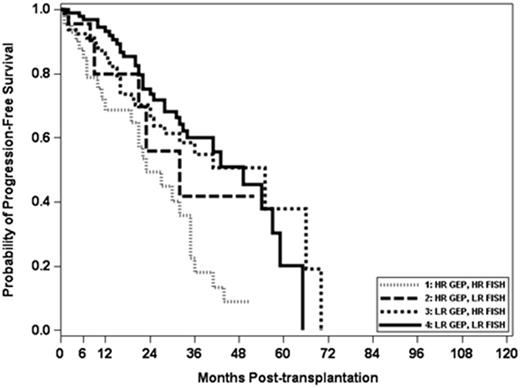Abstract
Background
Although there have been significant improvements in survival for patients with multiple myeloma (MM), those with high-risk disease defined by CD-138 selected FISH, gene-expression profiling, and cytogenetics have a median overall survival (OS) of 2 years or less. The mSMART classification defines high risk myeloma as del17p, t(14,16), t(14,20), and a high risk signature (cutoff of score 45.2) GEP. We aim to determine the prognostic significance of GEP together with FISH in a MM single center cohort.
Methods
232 newly diagnosed pts with MyPRSTM GEP, and CD-138 selected FISH results were analyzed. Risk classification was defined as above. Chi-square and Cox regression were used for statistical analysis. Overall survival (OS) and progression free survival (PFS) transplant were analyzed by Kaplan-Meier.
Results
Median age was 62 years (range, 25-90), 139 pts (60%) were men, and 57 pts (24%) had ISS 3. 60 pts (25%) had high-risk disease based on GEP with a median score of 36.5 (range, 9.03-84.05), and 81 pts (34%) had high-risk disease based on FISH. Median OS and PFS were significantly inferior in patients with high-risk by GEP vs low-risk GEP, 78% vs 89% (p<0.004), 61% vs. 67% (p<0.002) respectively. There was no statistically significant difference on OS based on FISH results. The double high-risk classification of high-risk GEP/high-risk FISH had statistically significant lower OS and PFS when compared to low-risk GEP/low-risk FISH (HR 2.64, 95%CI: 1.55-4.48, p<0.003), and (HR 2.74, 95%CI: 1.62-4.62, p<0.0002). It also had a trend towards worse OS and PFS that was not statistically significant compared to low-risk GEP/high-risk FISH (HR 1.29, 95%CI: 0.788-2.111, p<0.3115), and (HR 2.64, 95%CI: 1.55-4.48, p<0.003) respectively; and high-risk GEP/low-risk FISH (HR 1.66, 95%CI: 0.73-3.80, p<0.22), and (HR 1.43, 95%CI: 0.634-3.25, p<0.38) respectively. Finally the association of high-risk GEP and TP53 was not an independent predictor of worse OS or PFS (HR 0.831, 95%CI: 0.530-1.303, p<0.42) and (HR 0.962, 95%CI: 0.612-1.51, p<0.866), respectively.
Conclusions
GEP was an independent predictor of OS and PFS in our cohort. The combination of GEP and FISH to identify a double high risk population was not superior to GEP alone. This may be due to the fact that some high risk GEP subtypes are associated with high risk translocations reported by FISH, decreasing the role of high risk status by both GEP and FISH. Further prospective studies with larger samples and longer follow up periods are warranted to better characterize high risk MM pts.
Siegel: Celgene, Takeda, Amgen Inc, Novartis and BMS: Consultancy, Speakers Bureau; Merck: Consultancy. Richter: Takeda: Membership on an entity's Board of Directors or advisory committees, Speakers Bureau; Janssen: Speakers Bureau; Celgene: Membership on an entity's Board of Directors or advisory committees, Speakers Bureau; Amgen: Membership on an entity's Board of Directors or advisory committees, Speakers Bureau; BMS: Speakers Bureau. Vesole: Takeda: Speakers Bureau; Celgene: Speakers Bureau. Biran: Celgene, Amgen: Consultancy, Speakers Bureau; Takeda: Speakers Bureau.
Author notes
Asterisk with author names denotes non-ASH members.


This feature is available to Subscribers Only
Sign In or Create an Account Close Modal